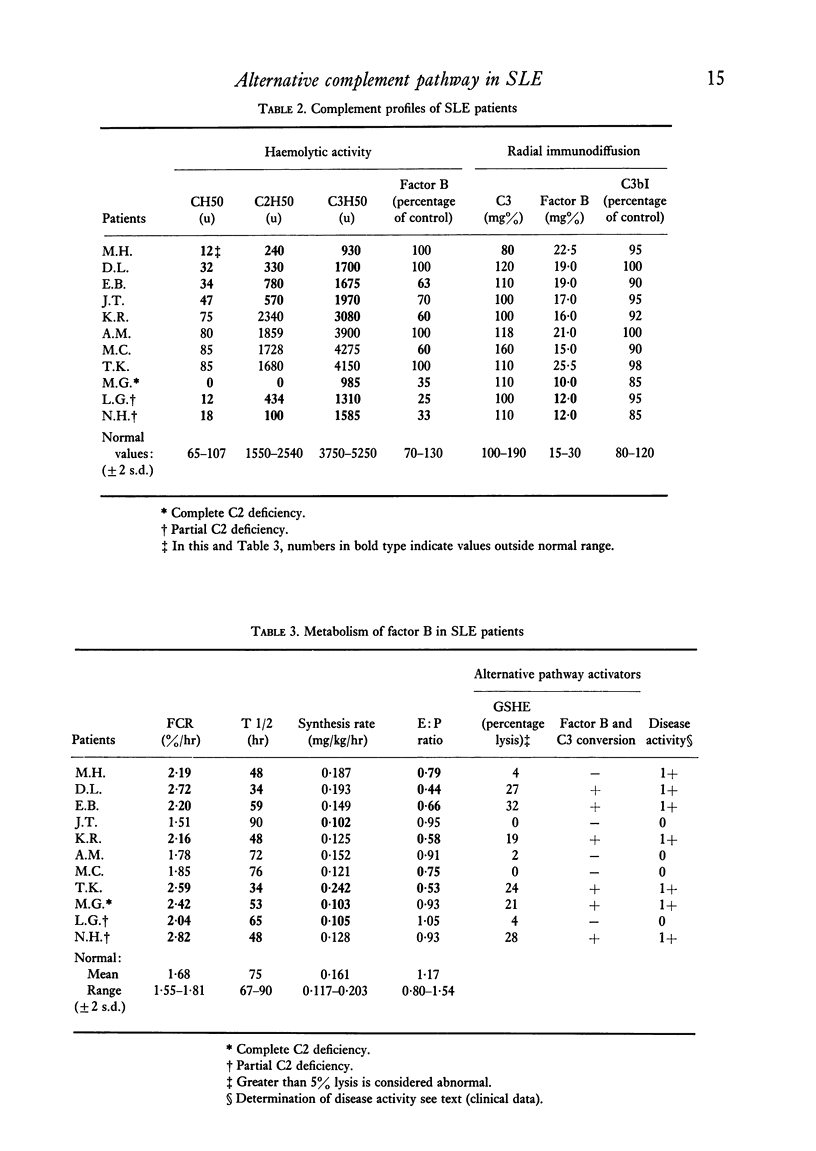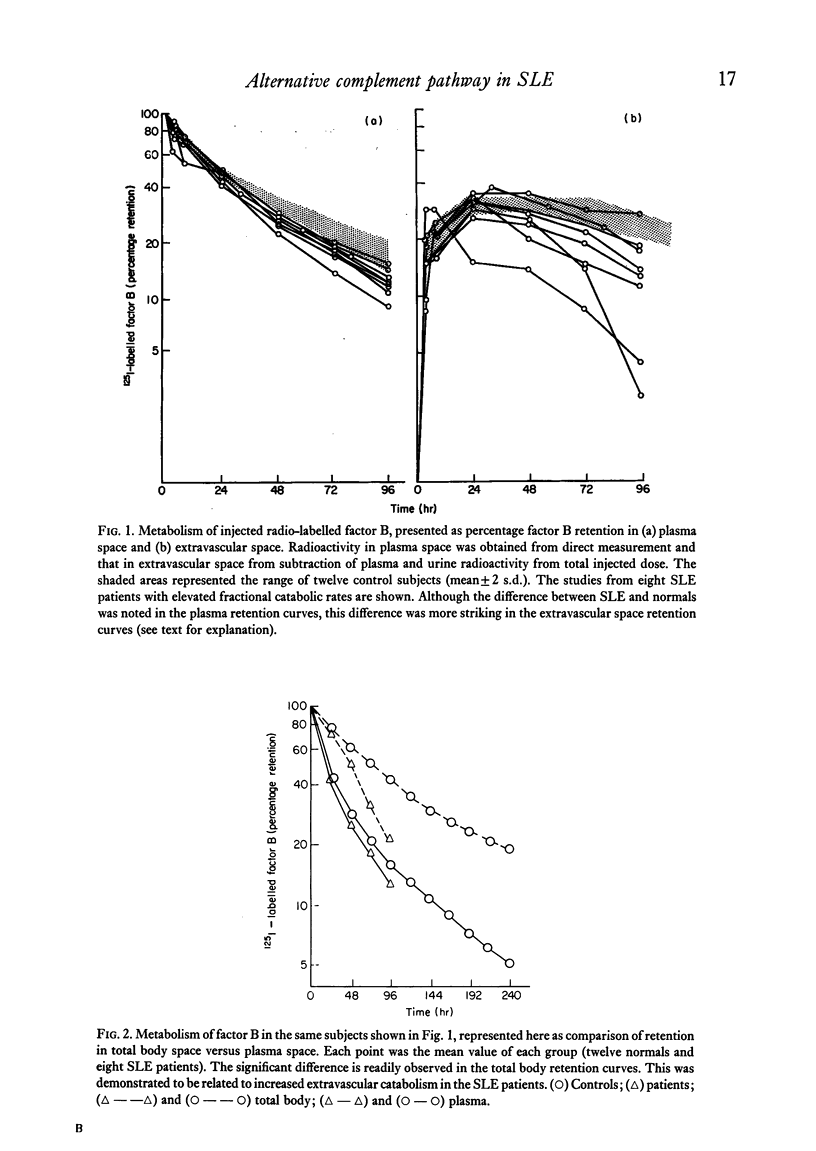Abstract
Serum factors activating the alternative pathway of complement in vitro, independent of classical pathway activation was demonstrated in six of eleven patients with systemic lupus erythematosus (SLE). These serum factors were detected by lysis of gluthathione-sensitized human erythrocytes and by C3 and factor B conversion in the presence of EGTA (10 mM) and MgCl2 (0-3 mM), conditions which blocked activation of the classical pathway but permitted activation of the alternative pathway. In order to determine if in vivo activation of the alternative pathway of complement was present in SLE, highly-purified factor B was labelled with radioactive iodine (125I), and its metabolism studied in the eleven patients with SLE and in twelve control subjects. All six patients with serum factors capable of activating the alternative pathway in vitro, had in vivo evidence of alternative pathway activation as measured by increased fractional catabolic rate (FCR) of factor B. Two patients without demonstrable alternative pathway activating factors in their sera had an elevated FCR of factor B. Six of the patients with increased FCR of factor B had disease limited to skin or joint and one had lupus nephritis which was inactive at the time of study. One of the four patients who were in clinical remission had elevated FCR. This study demonstrates that a significant number of patients with SLE of relatively mild disease activity had evidence of alternative complement pathway activation. This activation did not appear to be limited to patients with lupus nephritis and raises the possibility that it could also be related to some of the extra-renal manifestations of SLE.
Full text
PDF









Selected References
These references are in PubMed. This may not be the complete list of references from this article.
- Agnello V., De Bracco M. M., Kunkel H. G. Hereditary C2 deficiency with some manifestations of systemic lupus erythematosus. J Immunol. 1972 Mar;108(3):837–840. [PubMed] [Google Scholar]
- Agnello V., Koffler D., Eisenberg J. W., Winchester R. J., Kundel H. G. C1g precipitins in the sera of patients with systemic lupus erythematosus and other hypocomplementemic states: characterization of high and low molecular weight types. J Exp Med. 1971 Sep 1;134(3 Pt 2):228s–241s. [PubMed] [Google Scholar]
- Alper C. A., Rosen F. S. Alper CA, Rosen FS: Studies of the in vivo behavior of human C'3 in normal subjects and patients. J Clin Invest. 1967 Dec;46(12):2021–2034. doi: 10.1172/JCI105691. [DOI] [PMC free article] [PubMed] [Google Scholar]
- Arroyave C. M., Vallota E. H., Müller-Eberhard H. J. Lysis of human erythrocytes due to activation of the alternate complement pathway by nephritic factor (C3NeF). J Immunol. 1974 Sep;113(3):764–768. [PubMed] [Google Scholar]
- Arroyave C. M., Wilson M. R., Tan E. M. Serum factors activating the alternative complement pathway in autoimmune disease: description of two different factors from patients with systemic lupus erythematosus. J Immunol. 1976 Mar;116(3):821–826. [PubMed] [Google Scholar]
- Avrameas S., Ternynck T. Biologically active water-insoluble protein polymers. I. Their use for isolation of antigens and antibodies. J Biol Chem. 1967 Apr 10;242(7):1651–1659. [PubMed] [Google Scholar]
- Bokisch V. A., Müller-Eberhard H. J., Cochrane C. G. Isolation of a fragment (C3a) of the third component of human complement containing anaphylatoxin and chemotactic activity and description of an anaphylatoxin inactivator of human serum. J Exp Med. 1969 May 1;129(5):1109–1130. doi: 10.1084/jem.129.5.1109. [DOI] [PMC free article] [PubMed] [Google Scholar]
- Carpenter C. B., Ruddy S., Shehadeh I. H., Müller-Eberhard H. J., Merrill J. P., Austen K. F. Complement metabolism in man: hypercatabolism of the fourth (C4) and third (C3) components in patients with renal allograft rejection and hereditary, angioedema (HAE). J Clin Invest. 1969 Aug;48(8):1495–1505. doi: 10.1172/JCI106116. [DOI] [PMC free article] [PubMed] [Google Scholar]
- Charlesworth J. A., Williams D. G., Sherington E., Lachmann P. J., Peters D. K. Metabolic studies of the third component of complement and the glycine-rich beta glycoprotein in patients with hypocomplementemia. J Clin Invest. 1974 Jun;53(6):1578–1587. doi: 10.1172/JCI107708. [DOI] [PMC free article] [PubMed] [Google Scholar]
- Cohen A. S., Canoso J. J. Criteria for the classification of systemic lupus erythematosus--status 1972. Arthritis Rheum. 1972 Sep-Oct;15(5):540–543. doi: 10.1002/art.1780150512. [DOI] [PubMed] [Google Scholar]
- Cooper N. R., Polley M. J., Müller-Eberhard H. J. The second component of human complement (C2): quantitative molecular analysis of its reactions in immune hemolysis. Immunochemistry. 1970 Apr;7(4):341–356. doi: 10.1016/0019-2791(70)90237-5. [DOI] [PubMed] [Google Scholar]
- Gewurz H., Pickering R. J., Mergenhagen S. E., Good R. A. The complement profile in acute glomerulonephritis systemic lupus erythematosus and hypocomplementemic chronic glomerulonephritis. Contrasts and experimental correlations. Int Arch Allergy Appl Immunol. 1968;34(6):556–570. doi: 10.1159/000230149. [DOI] [PubMed] [Google Scholar]
- Götze O., Müller-Eberhard H. J. The C3-activator system: an alternate pathway of complement activation. J Exp Med. 1971 Sep 1;134(3 Pt 2):90s–108s. [PubMed] [Google Scholar]
- Hunder G. G., Mullen B. J., McDuffie F. C. Complement in pericardial fluid of lupus erythematosus. Studies in two patients. Ann Intern Med. 1974 Apr;80(4):453–458. doi: 10.7326/0003-4819-80-4-453. [DOI] [PubMed] [Google Scholar]
- Hunsicker L. G., Ruddy S., Carpenter C. B., Schur P. H., Merrill J. P., Müller-Eberhard H. J., Austen K. F. Metabolism of third complement component (C3) in nephritis. Involvement of the classic and alternate (properdin) pathways for complement activation. N Engl J Med. 1972 Oct 26;287(17):835–840. doi: 10.1056/NEJM197210262871701. [DOI] [PubMed] [Google Scholar]
- Kohler P. F., Ten Bensel R. Serial complement component alterations in acute glomerulonephritis and systemic lupus erythematosus. Clin Exp Immunol. 1969 Feb;4(2):191–202. [PMC free article] [PubMed] [Google Scholar]
- Levin J., Poore T. E., Young N. S., Margolis S., Zauber N. P., Townes A. S., Bell W. R. Gram-negative sepsis: detection of endotoxemia with the limulus test. With studies of associated changes in blood coagulation, serum lipids, and complement. Ann Intern Med. 1972 Jan;76(1):1–7. doi: 10.7326/0003-4819-76-1-1. [DOI] [PubMed] [Google Scholar]
- Mancini G., Carbonara A. O., Heremans J. F. Immunochemical quantitation of antigens by single radial immunodiffusion. Immunochemistry. 1965 Sep;2(3):235–254. doi: 10.1016/0019-2791(65)90004-2. [DOI] [PubMed] [Google Scholar]
- May J. E., Rosse W., Frank M. M. Paroxysmal nocturnal hemoglobinuria. Alternate-complement-pathway-mediated lysis induced by magnesium. N Engl J Med. 1973 Oct 4;289(14):705–709. doi: 10.1056/NEJM197310042891401. [DOI] [PubMed] [Google Scholar]
- McConahey P. J., Dixon F. J. A method of trace iodination of proteins for immunologic studies. Int Arch Allergy Appl Immunol. 1966;29(2):185–189. doi: 10.1159/000229699. [DOI] [PubMed] [Google Scholar]
- Muller-Eberhard H. J., Nilsson U. R., Dalmasso A. P., Polley M. J., Calcott M. A. A molecular concept of immune cytolysis. Arch Pathol. 1966 Sep;82(3):205–217. [PubMed] [Google Scholar]
- Nosslin B. Analysis of disappearance time-curves after single injection of labelled proteins. Ciba Found Symp. 1972;9:113–130. doi: 10.1002/9780470719923.ch7. [DOI] [PubMed] [Google Scholar]
- Osterland C. K., Espinoza L., Parker L. P., Schur P. H. Inherited C2 deficiency and systemic lupus erythematosus: studies on a family. Ann Intern Med. 1975 Mar;82(3):323–328. doi: 10.7326/0003-4819-82-3-323. [DOI] [PubMed] [Google Scholar]
- Perrin L. H., Lambert P. H., Miescher P. A. Complement breakdown products in plasma from patients with systemic lupus erythematosus and patients with membranoproliferative or other glomerulonephritis. J Clin Invest. 1975 Jul;56(1):165–176. doi: 10.1172/JCI108065. [DOI] [PMC free article] [PubMed] [Google Scholar]
- Perrin L. H., Lambert P. H., Nydegger U. E., Miescher P. A. Quantitation of C3PA (properdin factor B) and other complement components in diseases associated with a low C3 level. Clin Immunol Immunopathol. 1973 Nov;2(1):16–27. doi: 10.1016/0090-1229(73)90032-9. [DOI] [PubMed] [Google Scholar]
- Provost T. T., Tomasi T. B., Jr Evidence for complement activation via the alternate pathway in skin diseases, I. Herpes gestationis, systemic lupus erythematosus, and bullous pemphigoid. J Clin Invest. 1973 Jul;52(7):1779–1787. doi: 10.1172/JCI107359. [DOI] [PMC free article] [PubMed] [Google Scholar]
- ROTHFIELD N. F., PACE N. Relation of positive L.E.-cell preparations to activity of lupus erythematosus and corticosteroid therapy. N Engl J Med. 1962 Mar 15;266:535–538. doi: 10.1056/NEJM196203152661103. [DOI] [PubMed] [Google Scholar]
- Rothfield N., Ross H. A., Minta J. O., Lepow I. H. Glomerular and dermal depostion of properdin in systemic lupus erythematosus. N Engl J Med. 1972 Oct 5;287(14):681–685. doi: 10.1056/NEJM197210052871402. [DOI] [PubMed] [Google Scholar]
- Schur P. H., Sandson J. Immunologic factors and clinical activity in systemic lupus erythematosus. N Engl J Med. 1968 Mar 7;278(10):533–538. doi: 10.1056/NEJM196803072781004. [DOI] [PubMed] [Google Scholar]
- Sussman M., Jones J. H., Almeida J. D., Lachmann P. J. Deficiency of the second component of complement associated with anaphylactoid purpura and presence of mycoplasma in the serum. Clin Exp Immunol. 1973 Aug;14(4):531–539. [PMC free article] [PubMed] [Google Scholar]
- Vallota E. H., Götze O., Spiegelberg H. L., Forristal J., West C. D., Müller-Eberhard H. J. A serum factor in chronic hypocomplementemic hephritis distinct from immunoglobulins and activating the alternate pathway of complement. J Exp Med. 1974 May 1;139(5):1249–1261. doi: 10.1084/jem.139.5.1249. [DOI] [PMC free article] [PubMed] [Google Scholar]
- Ziegler J. B., Rosen F. S., Alper C. A., Grupe W., Lepow I. H. Metabolism of properdin in normal subjects and patients with renal disease. J Clin Invest. 1975 Sep;56(3):761–767. doi: 10.1172/JCI108147. [DOI] [PMC free article] [PubMed] [Google Scholar]


